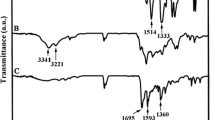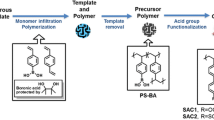Abstract
A novel ionic porous organic polymers catalysts were prepared and characterized by scanning electron microscopy, Brunner − Emmet − Teller measurements, fourier transform infrared spectroscopy and thermogravimetric analysis The characterization results showed that the synthesized catalyst was a porous polymer and had good heat stability. The catalytic performance of the catalyst was evaluated by synthesis of methacrolein from formaldehyde and propionaldehyde. The optimal reaction conditions were: the catalyst amount was 10%(wt%)of propionic aldehyde mass, the reaction temperature was 85 ℃, the reaction time was 1.5 h, the ratio of propionaldehyde and formaldehyde was 1:1.2. Under optimal condition, the conversion rate of propionaldehyde was up to 99.57% and the selectivity of methacrolein was 98.77%. The catalytic activity did not reduced obviously after being reused for 5 times. The reaction kinetics of synthesis of methacrolein was further studied. The results showed that the reaction order was 1.6, the activation energy was 50.28 kJ/mol and the pre-exponential factor was 4.17 × 107 (mol/L)−1.456/s.
Graphical Abstract














Similar content being viewed by others
References
Yan R, Lv Z, Tang H, Bai Y, Li M, Li Y (2021) Mechanistic insight into methacrolein formation from formaldehyde and propionaldehyde. Cata Lett, (prepublish). https://doi.org/10.1007/S10562-021-03679-5
Jiayuan Yu, Jensen AD, Wang L, Li C, Zhang S (2020) Catalytic synthesis of methacrolein via the condensation of formaldehyde and propionaldehyde with L-proline. Green Chem. https://doi.org/10.1039/D0GC00726A
Wan X, Deng W, Zhang Q, Wang Ye (2014) Magnesia-supported gold nanoparticles as efficient catalysts for oxidative esterification of aldehydes or alcohols with methanol to methyl esters. Catal Today 233:147–154. https://doi.org/10.1016/j.cattod.2013.12.012
Jing Ma, Xueqing Y, Yan N, Baohe W (2018) The influence of a hydrophobic carrier, reactant and product during H2O adsorption on Pd surface for the oxidative esterification of methacrolein to methyl methacrylate. Phys chem chem phys:PCCP 20(15):9965–9974. https://doi.org/10.1039/c8cp00609a
Zhao H, Li J, Wang L, Li C, Zhang S (2021) Pickering emulsion stabilized by dual stabilizer: a novel reaction/separation system for methacrolein synthesis. Chem Eng Sci. https://doi.org/10.1016/j.ces.2020.116038
Coindre VF, Kinney SM, Sefton MV (2020) Methacrylic acid copolymer coating of polypropylene mesh chamber improves subcutaneous islet engraftment. Biomaterials. https://doi.org/10.1016/j.biomaterials.2020.120324
Mahboub D, Jaber M, Dubois J-L, Cavani F, Rostamizadeh M, Patience GS (2018) Catalysis for the synthesis of methacrylic acid and methyl methacrylate. Chem Soc Rev 47:7703–7738. https://doi.org/10.1039/C8CS00117K
Mangal U, Kim J-Y, Seo J-Y, Kwon J-S, Choi S-H (2019) Novel poly(Methyl Methacrylate) containing nanodiamond to improve the mechanical properties and fungal resistance. Materials 12(20):3438
Li Z, Sébastien P, Franck D, Benjamin K (2021) Selective oxidation of isobutane to methacrylic acid and methacrolein: a critical review. Catalysts. https://doi.org/10.3390/CATAL11070769
Yanchun L, Jingfang He, Wenling C, Weishen Y (2018) Polyoxometalate catalysts with co-substituted VO2+ and transition metals and their catalytic performance for the oxidation of isobutane. Catal Sci Technol. https://doi.org/10.1039/c8cy01101j
Zhao H, Ran R, Wang L, Li CS (2020) Novel continuous process for methacrolein production in numerous droplet reactors. AIChE J 66(7):16239
Deshpande RM, Diwakar MM, Mahajan AN, Chaudhari RV (2003) Biphasic catalysis for a selective oxo–Mannich tandem synthesis of methacrolein. J Mol Catal A, Chem 211(1):49–53. https://doi.org/10.1016/j.molcata.2003.10.010
Dumitriu E, Hulea V, Fechete I, Auroux A, Lacaze J-F, Guimon C (2001) The aldol condensation of lower aldehydes over MFI zeolites with different acidic properties. Microporous Mesoporous Mater 43(3):341–359. https://doi.org/10.1016/S1387-1811(01)00265-7
Lei L, Tao R, Shi J, Jing X, Ma H (2017) Rapid and continuous synthesis of methacrolein with high selectivity by condensation of propanal with formaldehyde in laboratory. Can J Chem Eng 95(10):1985–1992. https://doi.org/10.1002/cjce.22821
Chao LY, Yi YR, Lei W, Liu Lu, Dan L, Heng Z, Yan DY, Xi LZ, Jiang ZS (2011) Synthesis of methacrolein by condensation of propionaldehyde with formaldehyde. Adv Mater Res 396:396–398. https://doi.org/10.4028/WWW.SCIENTIFIC.NET/AMR.396-398.1094
Wang G, Li Z, Fan L, Li C, Zhang S (2019) Sec -amine grafted D301 resin catalyzed fixed-bed process for continuous preparation of methacrolein via Mannich reaction. Chem Eng J. https://doi.org/10.1016/j.cej.2019.03.198
Li Z, Li He, Wang D, Suwansoontorn A, Du G, Liu Z, Hasan Md, Mahmudul; Nagao, Yuki, (2020) A simple and cost-effective synthesis of ionic porous organic polymers with excellent porosity for high iodine capture. Polymer. https://doi.org/10.1016/j.polymer.2020.122796
Lipeng Z, Shuzhuan S, Pengjing C, Yuwei Z, Sun Qikun Xu, Yujie QW, Riming N, Zhongping Li, Liwei Mi (2021) Constructing cationic covalent organic frameworks by a post-function process for an exceptional iodine capture via electrostatic interactions. Mater Chem Front. https://doi.org/10.1039/D1QM00416F
Slater AG, Andrew I (2015) Cooper function-led design of new porous materials. Science. https://doi.org/10.1126/science.aaa8075
Das S, Heasman P, Ben T, Qiu S (2017) Porous organic materials: strategic design and structure-function correlation. Chem Rev 117(3):1515–1563. https://doi.org/10.1021/acs.chemrev.6b00439
Chandra D, Bhaumik A (2009) A new functionalized mesoporous polymer with high efficiency for the removal of pollutant anions. J Mater Chem 19(13):1901. https://doi.org/10.1039/b818248e
Tan L, Tan B (2017) Hypercrosslinked porous polymer materials: design, synthesis, and applications. Chem Soc Rev. https://doi.org/10.1039/c6cs00851h
Gomes R, Bhaumik A (2015) Highly porous organic polymers bearing tertiary amine group and their exceptionally high CO2 uptake capacities. J Sol State Chem. https://doi.org/10.1016/j.jssc.2014.10.032
Shen S, Zhang L, Zhang Y, Zhang G, Yang J, Bai R (2019) Fabrication of antifouling membranes by blending poly (vinylidene fluoride) with cationic polyionic liquid. J Appl Polym Sci. https://doi.org/10.1002/app.48878
Zhao W, Xia L, Liu X (2018) Covalent organic frameworks (COFs): perspectives of industrialization. CrystEngComm. https://doi.org/10.1039/C7CE02079A
Wang J, Sng W, Yi G, Zhang Y (2015) Imidazolium salt-modified porous hypercrosslinked polymers for synergistic CO2 capture and conversion. Chem Commun 51(60):12076–12079. https://doi.org/10.1039/c5cc04702a
Zhang P, Qiao Z-A, Jiang X, Veith GM, Dai S (2015) Nanoporous ionic organic networks: stabilizing and supporting gold nanoparticles for catalysis. Nano Lett 15(2):823–828. https://doi.org/10.1021/nl504780j
Sun Qi, Ma S, Dai Z, Meng X, Xiao F (2015) Hierarchical porous ionic organic polymer as a new platform for heterogeneous phase transfer catalysis. J Mater Chem A. https://doi.org/10.1039/C5TA07267K
Wang J-Q, Yang JG, Wei; Yi, Guangshun; Zhang, Yugen, (2015) Phosphonium salt incorporated hypercrosslinked porous polymer for CO2 capture and conversion. Chem Commun. https://doi.org/10.1039/C5CC06295K
Harshita G, Ruichi Z, Jakub M, Tiina L, Jaakko R, Juha T (2021) Vanadium removal by cationized sawdust produced through iodomethane quaternization of triethanolamine grafted raw material. Chemosphere. https://doi.org/10.1016/J.CHEMOSPHERE.2021.130445
Pei A, Butchosa N, Berglund LA, Zhou Q (2013) Surface quaternized cellulose nanofibrils with high water absorbency and adsorption capacity for anionic dyes. Soft Matter. https://doi.org/10.1039/C2SM27344F
Salajková M, Berglund LA, Zhou Qi (2012) Hydrophobic cellulose nanocrystals modified with quaternary ammonium salts. J Mater Chem 22(37):19798. https://doi.org/10.1039/c2jm34355j
Yaxin D, Xin Li, Rui W (2021) Carboxyl functional group-assisted defects passivation strategy for efficient air-processed perovskite solar cells with excellent ambient stability[J]. Sol Energy Mater Sol Cells. https://doi.org/10.1016/J.SOLMAT.2021.111242
Zhao H, Li J, Wang L, Li CS, Zhang SJ (2021) Pickering emulsion stabilized by dual stabilizer: a novel reaction/separation system for methacrolein synthesis. Chem Eng Sci 229:116038
Yu J, Jensen AD, Wang L, Li CS (2020) Catalytic synthesis of rnethacrolein via the condensation of formaldehyde and propionaldehyde with L-proline. Green Chem 22:4222–4423
Takahashi A, Fujitani T (2020) Kinetic-model-based design of industrial reactor for catalytic hydrogen production via ammonia decomposition. Chem Eng Res Des 165:333–340. https://doi.org/10.1016/j.cherd.2020.11.004
Acknowledgements
This research was supported by the national natural science foundation of China (NO. 21106032), natural science foundation of Hebei province (NO. B2021103012).
Funding
Natural Science Foundation of Hebei Province,NO. B2021103012, National Natural Science Foundation of China, NO. 21106032
Author information
Authors and Affiliations
Corresponding author
Ethics declarations
Conflict of interest
The authors declare no competing financial interest.
Additional information
Publisher's Note
Springer Nature remains neutral with regard to jurisdictional claims in published maps and institutional affiliations.
Rights and permissions
Springer Nature or its licensor holds exclusive rights to this article under a publishing agreement with the author(s) or other rightsholder(s); author self-archiving of the accepted manuscript version of this article is solely governed by the terms of such publishing agreement and applicable law.
About this article
Cite this article
Wang, Y., Liu, W., Zhang, J. et al. Synthesis of Novel Ionic Porous Organic Polymers and Its Application in Hydroxyl Condensation Reaction. Catal Lett 153, 1797–1806 (2023). https://doi.org/10.1007/s10562-022-04110-3
Received:
Accepted:
Published:
Issue Date:
DOI: https://doi.org/10.1007/s10562-022-04110-3




